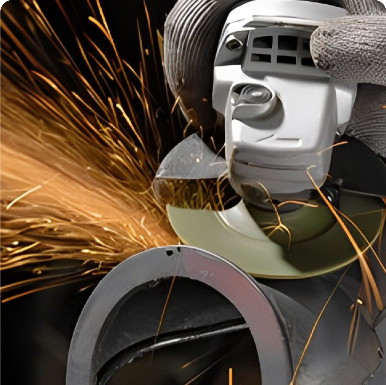Different Types of Grinding Wheels A Comprehensive Guide
Grinding wheels are indispensable tools in various industries, particularly in metalworking. They are used in grinding machines for shaping, sharpening, and finishing metal as well as other materials. Understanding the different types of grinding wheels is crucial for selecting the right one for a specific application. This article aims to explore the various types of grinding wheels, their compositions, specifications, and ideal applications.
1. Bonding Materials
The composition of grinding wheels can be broadly categorized into two types based on the bonding materials used
- Vitrified Bond Made from a mixture of clay and other materials, these wheels are baked at high temperatures. Vitrified bond wheels are known for their strength, durability, and resistance to thermal and mechanical shocks. They are commonly used for precision grinding tasks, such as sharpening tools and finishing hard materials.
- Resin Bond Made from synthetic resins, these grinding wheels offer flexibility and good cutting performance. They are ideal for applications that require a smoother finish and are commonly used in manufacturing, construction, and maintenance tasks.
- Metal Bond Metal bond wheels hold abrasives in a metal matrix and are used for grinding hard materials like ceramics and carbide. They provide a longer lifespan and maintain shape stability under high temperatures, making them suitable for heavy-duty applications.
2. Types of Abrasives
The abrasive material used in grinding wheels significantly influences their performance. The commonly used abrasives include
- Aluminum Oxide This is the most widely used abrasive. It is suitable for grinding ferrous metals and is available in various grades to cater to different applications.
- Silicon Carbide Known for its sharpness, silicon carbide is used for grinding non-ferrous metals and materials like glass and ceramics. It is less durable than aluminum oxide but provides a finer finish.
- Diamond Diamond wheels are the hardest and most expensive type of grinding wheels. They are used for grinding ultra-hard materials and provide exceptional performance in precision tasks.
3. Wheel Shapes and Sizes
Grinding wheels come in various shapes and sizes, each designed for specific applications. Here are some common shapes
- Flat Wheels Used for surface grinding, flat wheels have a broad grinding surface that provides a consistent finish over large areas.
- Depressed Center Wheels These wheels are designed for cutting and grinding at angles
. They are widely used in metal fabrication and heavy construction.different types grinding wheels

- Cylinder Wheels Ideal for grinding the edges of materials, cylinder wheels are often employed in tool sharpening and finishing operations.
- Cup Wheels With a cup-like shape, these wheels are used for smoothening curvature and are beneficial in grinding metal and concrete.
4. Applications of Grinding Wheels
The applications of grinding wheels span across multiple industries, including
- Manufacturing Used for tool and die making, producing precise components that require tight tolerances.
- Automotive Essential for reconditioning engine parts, grinding valves, and finishing various automotive components.
- Construction Employed for leveling surfaces, cutting concrete tiles, and masonry work.
- Jewelry Making Specialized grinding wheels are used for shaping and polishing gemstones and metals.
5. Selecting the Right Grinding Wheel
To select the right grinding wheel, consider the following factors
- Material Type Match the wheel with the material to be ground, ensuring that the abrasive is suitable.
- Grain Size Coarse grains are suitable for rapid material removal, while finer grains provide a smoother finish.
- Wheel Speed Ensure that the wheel’s speed rating matches your grinding machine’s specifications to avoid accidents.
- Application Understand the specific requirements of your project to choose a wheel that meets the operational needs.
Conclusion
Grinding wheels are vital tools in the manufacturing and maintenance sectors. By understanding the different types, compositions, and applications of grinding wheels, professionals can make informed decisions, enhance productivity, and ensure high-quality finishing of their projects. Whether in a workshop or an industrial setting, the right grinding wheel can make all the difference in achieving optimal results.
Post time:Dec - 24 - 2024

















